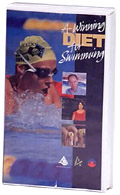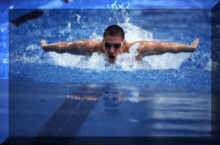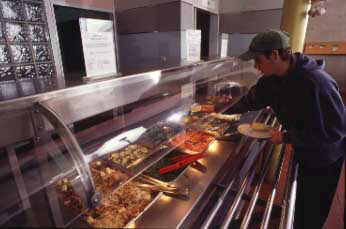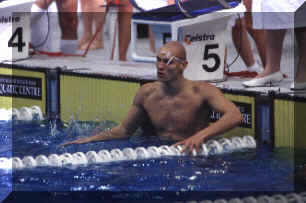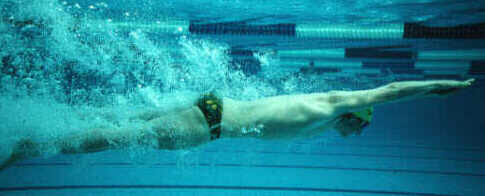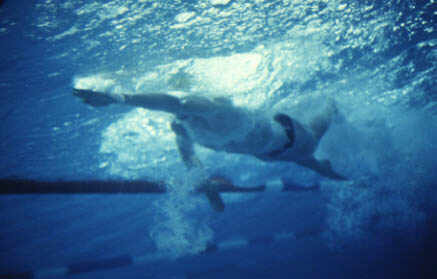 | ||
 |
||
|
| ||
 |
|||||||||||||||||||||||||||||||||||||||||||||||||
Swimming Characteristics of Swimming Training Swimming requires a serious commitment to training. Typically, 6-12 sessions are undertaken each week, with the distance covered in each session ranging from 1000-2000 metres of quality work for a sprinter in taper phase to 10 kilometres for a distance swimmer in the base phase of training. At the elite level workloads can involve 2-3 daily sessions adding up to 6 hours of training per day. In addition, swimmers may undertake some land-based aerobic training such as running or cycling as well as weight training sessions. Training commitments are usually smaller at the club or school level. Competition Olympic swimming events last from 20 seconds to 15 minutes. Swimming is therefore a highly anaerobic sport, with aerobic metabolism becoming more important as the race distance increases. Although each event may be brief, swim meets are usually held over 3 to 7 days, with swimmers typically competing in heats in the mornings and finals in the evening. In minor carnivals, swimmers may enter a large number of events and be required to swim 2 or 3 times in one day with 20 minutes to several hours between events. Important physical characteristics for swimming Swimmers tend to be tall with pronounced upper body muscle development. Low body fat is an advantage, since swimmers need to move their body weight through water. However, some body fat in the right distribution may enhance flotation. Other issues Many top swimmers are in their teens. Male adolescence is a period of heavy growth and muscular development, requiring high-energy support. For males, the addition of an intense training program means male swimmers can have trouble eating enough kilojoules to meet energy needs. Adolescence for females brings hormonal changes, which promote an increase in body fat. Despite heavy training loads, many female swimmers can struggle to maintain low body fat levels. Long training hours restrict a swimmer's lifestyle. This can either reduce the opportunities to eat in a busy daily schedule or raise the importance of eating for comfort or entertainment. Access to food can also be an issue when at swimming carnivals, and for athletes frequently travelling to compete. Common Nutrition Issues in Swimming Daily recovery Strenuous daily training requires a high-energy, high-carbohydrate diet. Swimmers who fail to consume enough carbohydrate will fail to recover adequately between training sessions resulting in fatigue, loss of body weight and poor performance. Additional energy requirements for growth may compound the problem. Swimmers with high-energy requirements need to increase the number of snacks during the day and make use of energy-dense foods. It is good to have nutritious carbohydrate-rich snacks on hand to eat straight after training to start the refueling process. This is especially important for swimmers who travel long distances from their pool to work or home and have to wait until the next meal can be consumed. Fluid needs in training High-intensity exercise in the steamy environment of a heated indoor pool, or outdoors in the sun, can lead to moderate sweat losses, which are not obvious when the swimmer is already wet. Smart swimmers bring drink bottles to the pool deck and drink during rest periods or between sets. Sports drinks provide an additional fuel supply for long training sessions. In a fluid balance study undertaken on the Australian Swimming team in Atlanta in 1995, we measured average sweat losses of ~125 ml per kilometre swum in training or about 600 ml per workout. These swimmers were provided with both water and sports drink at the session and managed an average intake that perfectly matched their losses (125 ml per km). Of course, some swimmers were better at matching losses than others. And during anaerobic threshold sets, sweat losses increased to 170 ml/km. Iron status An iron imbalance may occur in swimmers undertaking heavy training who fail to consume sufficient iron. Female swimmers on weight loss diets are particularly at risk. Iron levels should be checked regularly when in heavy training. Iron-rich foods such as lean red meat and breakfast cereals fortified with iron (eg Kellogg's Sustain or Just Right) should be included regularly in the diet. Iron-rich plant foods such as wholegrain cereals, spinach and legumes should be combined with animal iron sources (eg wholegrain pasta with bolognaise sauce) and vitamin C sources (eg glass of orange juice consumed with breakfast cereal) to improve iron absorption. A sports dietitian will be able to provide specific dietary help. Immune status Swimmers often worry about getting sick during periods of heavy training. Many nutritional supplements and strategies have been suggested to keep the swimmer from catching coughs and colds. To date, the most important strategy emerging from immune studies of athletes is to keep well fuelled during training sessions. Sports drink during the work-out and a recovery snack or meal afterwards help to reduce the stress on the immune system seen in the hours after the session. Competition nutrition Muscle glycogen stores can be filled by 24 hours of a high-carbohydrate diet and rest. Swimmers who are undertaking a long taper may need to reduce total energy intake to match their reduced workload; otherwise unwanted gains in body fat will occur. Fluid levels and carbohydrate stores need to be replenished between events and between heats and semifinals/finals. Drink a carbohydrate-containing fluid such as sports drink, fruit juice or soft drink when there is only a short interval between races. Snacks such as yoghurt, fruit, cereal bars or sandwiches are suitable for longer gaps between races, or for recovery at the end of a session. Between day heats and evening final sessions, most swimmers eat a high-carbohydrate lunch and have a nap. On waking, a carbohydrate-rich snack is eaten before returning to the pool. Case Study: Grant – Chewing through the carbos Grant was a young up and coming swimmer who began to struggle with fatigue after making the jump to training with an elite squad. As Grant's training sessions increased to 12 per week, his times began to drop off and he struggled to maintain weight. A sports dietitian examined Grant's diet and found additional carbohydrates were needed to cover Grant's extra training needs. In particular, more carbohydrate foods were needed for Grant to replenish muscle glycogen stores between sessions. At 80 kg, a daily intake of 600-800 g of carbohydrate each day was required. Although Grant loved to eat high carbohydrate foods such as bread, cereal, fruit, potato, rice and pasta, he struggled to consume sufficient quantities each day of these bulky foods. Grant's dilemma was solved by increasing the number of meals consumed and making use of portable, easy-to-eat snacks. With some planning and preparation Grant made sure he always had access to quick easy-to eat high carbohydrate snacks such as smoothies, Sustagen Sport, cereal bars, sports drink, yoghurt, fruit and bread. He started having carbohydrate-rich foods and drinks immediately after each training session so that muscle glycogen storage was activated as quickly as possible. Grant's intake was increased to 800-900 g of carbohydrate and 21 000 to 23 000 kilojoules each day. Within three weeks Grant had regained some weight and was feeling a new energy at training.
The AIS Department of Sports Nutrition has produced a video on nutrition for swimming titled A Winning diet for swimming. You will find details and ordering information on our Resources - Videos page.
You will find more information about swimming at the
Australian Institute of Sport on the
|
| ||||||||||||||||||||||||||||||||||||||||||||||||
|
The Department of Sports Nutrition is a program of the
Australian Institute of Sport General enquires can be emailed to: aisnutrition@ausport.gov.au Copyright
© Australian Sports Commission
| |||||||||||||||||||||||||||||||||||||||||||||||||

